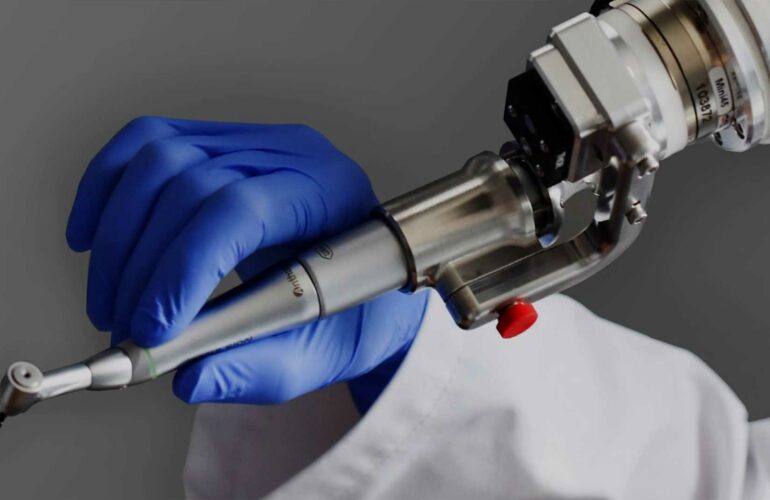All-on-4 Dental Implants
If you need more than one tooth replacement, you may want to consider All-on-4 dental implants. The cost of dental implants for an entire mouth restoration can be high, so you’ll almost certainly be looking at ways to save money on your treatment. All-on-4 implants cost less than a full set of dental implants, as they require fewer implants in the jaw than traditional methods.
In this article, we’ll answer questions you might have about getting All-on-4 dental implants such as:
- What does it involve?
- Is this type of implant safe?
- Are there ways to lower the cost further?
- What’s the difference between implants and dentures?
What are All-on-4 dental implants?
All-on-4, a registered trademark of Nobel Biocare, is a technique for replacing teeth using fewer implants than traditional methods. This technique has the following three traits:
1. As few as four implants per jaw
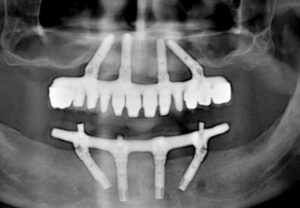
Where a full mouth of implants using traditional methods would require 8-10 implants per jaw, the Nobel Biocare All-on-4 technique uses just four. Sometimes five or six are needed on the upper jaw due to lower bone density.
2. Angled rear implants for optimum strength
Rather than being inserted vertically, the rear implants are at a 30-45 degree angle.
This angle reduces the need for bone augmentation and means even patients who have suffered bone loss should be eligible for All-on-4, usually with minimal grafting.
3. The ability to be implanted and fitted in a day
You don’t have to wait until after the All-on-4 dental implant recovery time is over to get your new teeth. This last trait has earned them the nickname ‘teeth in a day’, ‘smile in a day’, or ‘same day teeth’. This is a drastic improvement on traditional implant procedures which can take six months or more to complete with extensive recovery time at each step of the process.
This is not the only system for people who want an immediate full arch restoration. For instance, the Straumann Pro Arch system offers similar benefits. But we will use the term ‘All-on-4′ in this article since it is the term most people use to talk about this type of teeth implant.
All-on-4 procedure benefits
All-on-4 dental implants offer many benefits over conventional implants and dentures. These include:
- Short treatment and recovery time
- Implants placed on the same day as extraction
- Comfortable and stable structure to support crowns and bridges
- Fixed in place; no need to remove for cleaning
- Don’t slip or fall out
- Suitable for patients with jaw bone loss
- Cheaper than traditional techniques that use 8-10 implants
All-on-4 is an excellent treatment for patients who:
- Have neglected their teeth for a long time
- Have teeth that cannot be restored
This is also a good treatment for those who are self-conscious about how their teeth look and want a better alternative to a denture.
These patients can come to the Amelia Perfect Smile dental office with their natural, unrestorable teeth and have an All-on-4 implant treatment done in as little as half a day They will walk out with a brand new set of teeth and a fantastic smile.
This treatment’s only downfall is that the patient is getting between 4 to 6 implants in their jaw, with a fixed prosthesis on it. Oral hygiene is not as easy as getting a single implant and crown on every missing tooth.
All-on-4 vs. dentures
All-on-4 implants are sometimes mistakenly referred to as ‘All-on-4 dentures.’ That’s probably because the traditional way to replace a full jaw of teeth is with removable dentures, which consist of a gum-colored acrylic base and teeth made from resin or porcelain.
Dentures fit over the gums and stay in place either with suction alone or with a dental adhesive. Properly fitted dentures should not require adhesive and may indicate the need of / for dental implants.
However, the supporting bone shrinks over time as there are no teeth for it to hold in place, and this change of shape will cause dentures to become loose. This means they need to be replaced regularly to avoid discomfort and problems eating.
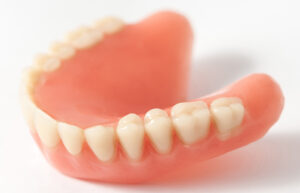
Removable dentures are custom-made to precisely fit the patient’s mouth. The upper denture covers the roof of the mouth and the lower one is a horseshoe shape to allow room for the tongue.
They must be removed for cleaning, usually overnight (hence the cliché of false teeth in a glass on the nightstand).
In contrast, All-on-4 implants are fixed in place and should act just like natural teeth in terms of appearance, chewing, and comfort. There is no risk of them slipping out of place while the wearer is talking or eating after All-on-4 implants placement.
Although the prosthetic teeth are fixed to a synthetic gum, this covers only a small area of the real gum when compared to dentures. The join is hidden far enough behind the lips that it won’t be visible when you smile.
Dentures offer a clear cost advantage over any kind of implant but they do need to be replaced every five years on average.
There is a tooth-replacement method that exists somewhere in between standard removable dentures and All-on-4 implants, and that would be snap-in implant dentures. They normally require fewer than four implants, providing less security than All-on-4s, but more than dentures. Like dentures, they are removed at night.
All-on-4 vs. regular implants
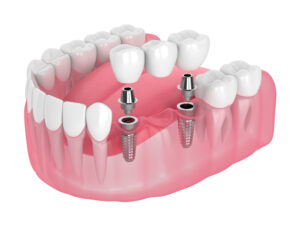
The conventional way to replace a full jaw of teeth is with a combination of single-tooth implants and implant-supported dental bridges.
Bridges allow several ‘teeth’ to be supported by one implant at each end instead of one implant per tooth. This technique usually requires 8-10 implants per jaw to replace all teeth.
While both techniques involve drilling sockets in the jaw bone, All-on-4 requires fewer implants. This makes the process quicker, easier, and more comfortable for the patient. It can also be considerably cheaper because of the reduction in time and materials required.
Aside from the lower cost, a big advantage of All-on-4 is the reduced treatment time. Dentures can be affixed as soon as the implants have been placed, rather than the patient having to wait for healing as is the case with traditional implants.
Usually, temporary dentures are placed on the day of surgery and permanent ones are added later. But whether you get All-on-4 or regular implants, the material will likely be either titanium or zirconia.
The following table shows the key differences between dentures, regular implants, and All-on-4:
[table id=1 /]
The fitting procedure
Initial consultation
Your first step in the procedure will be a consultation with your Amelia Perfect Smile implant specialist. During this consultation, we will examine your mouth and do a CT scan.
This scan lets us assess your suitability for implants. We can check your existing jaw bone density to determine precisely where the implants should be inserted.
If you are a suitable candidate and decide to go ahead, the next step will be to digitally scan your teeth. At Amelia Perfect Smile, we craft crowns right in our on-premises lab using state-of-the-art computerized dental milling systems from the hardest and most resilient materials available today.
We may also take a 3D cone beam CT scan to help with planning your treatment.
Surgery
If you need to have teeth extracted before your implants are inserted, this can usually be done on the same day.
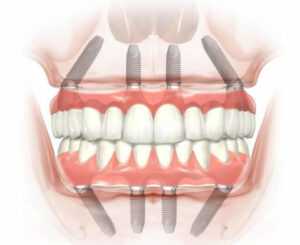 Your implant specialist will probably offer you a sedative to help you relax during the procedure. Then they will anesthetize you so you don’t feel any pain during implant surgery.
Your implant specialist will probably offer you a sedative to help you relax during the procedure. Then they will anesthetize you so you don’t feel any pain during implant surgery.
If you would prefer to have a general anesthetic for your All-on-4 treatment, ask your dentist about this at your initial consultation.
After any remaining teeth are extracted your mouth will be thoroughly cleaned to remove any damaged tissue and bacteria.
The dentist drills two or more holes at the front of your jaw to hold the front implants. Two holes at the rear, one on each side, are angled to offer greater support to the rear of the bridge.
Once the implants are placed, your mouth is cleaned again and any incisions are stitched up. It’s common for dentists to use dissolvable stitches which disappear after a week or two.
Either the same day or the following day you’ll be fitted with your new teeth. Some dentists create a temporary overdenture at this stage which is then replaced a few months later.
This is often made from resin, a lighter but less durable material, which puts less pressure on your All-on-4 implants while they heal.
Aftercare
Patients usually experience some bruising, swelling, and general discomfort in the days after their surgery. You’ll probably want to take a couple of days off work to recover fully and get used to your new teeth.

Our specialist will advise you on the type of foods you can and cannot eat in the months after your treatment.
For a while, you’ll probably have to stick to very soft foods so you don’t disturb the process of the implants fusing with your bone. You might also be advised to avoid things like smoking and heavy exercise for a while.
These implants are cleaned just like your normal teeth, by brushing twice a day. We will also show you how to floss with special tools.
You might want to invest in a water flosser with special attachments designed to clean around implants.
Final checks and fitting
If you look after your new teeth carefully, they should last for 20 years or longer. You’ll need to return to your dentist for regular checkups and maintenance.
Call us to discuss your treatment plan at your initial consultation. Remember, if you’re not a suitable candidate for All-on-4 we will recommend an alternative treatment.



